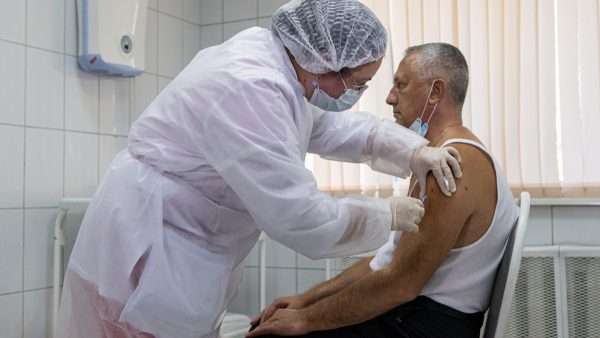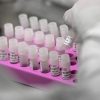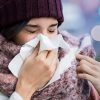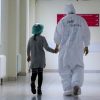 As the world slowly begins to vaccinate people against coronavirus, more and more often people can hear another panicky argument about why nothing will work. It sounds very plausible: the vaccine does not protect against the infection, it protects only from a severe course of illness, which means that the vaccinated people can catch the virus and spread it. Will the pandemic never end? This question was answered by a molecular biologist, science journalist, author of the book about coronavirus “The Virus That Broke the Planet”, Irina Yakutenko.
As the world slowly begins to vaccinate people against coronavirus, more and more often people can hear another panicky argument about why nothing will work. It sounds very plausible: the vaccine does not protect against the infection, it protects only from a severe course of illness, which means that the vaccinated people can catch the virus and spread it. Will the pandemic never end? This question was answered by a molecular biologist, science journalist, author of the book about coronavirus “The Virus That Broke the Planet”, Irina Yakutenko.
Different people talked a lot about the fact that the vaccine against coronavirus may not protect against the infection itself. However, the key word here is “may”. Based on the results of the third phase of trials of all the leading vaccines, we do not yet have data that would unequivocally testify in favor of the fact that the vaccine effectively prevents – or, conversely, does not prevent – massive infection and asymptomatic carriage.
We have the most information on the Pfizer / BioNTech vaccine, so let’s take a look at them. An article in the NEJM, which presents data on the safety and efficacy of the vaccine, said that of the 36,523 participants who received both doses of the vaccine or placebo, symptomatic covid occurred in 8 people in the vaccine group and in 162 people in the placebo group. In other words, the risk of getting sick is 95% lower in the vaccine group than in the placebo group.
This is a significant difference, which tells us that antibodies and T cells – machines for killing infected cells – in the body of the vaccinated people effectively recognize the virus and destroy it before it multiplies so much that the body feels bad. And it feels bad both from the fact that the virus itself kills a lot of different cells, and from the fact that the immune system, having detected a huge number of viral particles, is excited and triggers a systemic response, with all its unpleasant manifestations like fever, chills and generally bad state. All this usually happens when the coronavirus infection is already beginning to slowly descend from the upper respiratory tract to the lower.
At the same time, the virus jumps to other people not from the lower respiratory tract, but from the upper one– in fact, thanks to this feature, SARS-CoV-2 is much more infectious than its much more deadly relative, the SARS virus.
Does the vaccine protect one against covid?
The most interesting events from the point of view of the spread of the infection occur precisely in the upper respiratory tract – nasopharynx and oropharynx – in the first days after infection. If the virus has time to multiply strongly there, the person who caught it will be contagious, if not, he will not be contagious or not as much.
The vaccine is neither a talisman nor a force field, it does not create an invisible shell around the vaccinated person through which viruses cannot penetrate. The mucous membranes of the vaccinated people in the same way can get viral particles that are, for example, flying out of the mouth of an infected interlocutor, which do not know that the new host is vaccinated, and immediately begin to do what they can – namely, look for cells with ACE2 receptors, cling to these receptors with the help of the spike protein, crawl inside the cells, take control over them and force the infected cells to synthesize new viral particles.
It’s just that the immune system of the vaccinated very quickly recognizes the enemy and immediately starts the synthesis of specific, precisely tuned antibodies that most effectively prevent the binding of the spike protein to the receptors. And the T cells activated according to the instructions saved after vaccination will quickly destroy the cells that the virus has already infected.
All these stripping operations are very fast, but are still not instantaneous. For a while, the virus, which is not noticed by the special spies of the immune system, will enter cells, synthesize new copies of itself and leave the cells outside in search of new victims.
After vaccination, you may not get sick, but can you infect others?
Can coronavirus multiply in the upper respiratory tract of a vaccinated person to an amount when droplets of saliva and mucus flying out of the mouth carry enough viral particles so that they can begin to multiply steadily as soon as they get to the mucous membranes of the unvaccinated person?
It is quite possible to answer this question experimentally, not from general considerations or indirectly, extracting some coefficients from the epidemiological data on those who are infected. In order to do this, you need to take a vaccinated person, infect them with coronavirus, and then during the most dangerous first days in terms of virus transmission, determine the number of viral particles in the upper respiratory tract. To be absolutely sure, you can put these vaccinated people next to the unvaccinated and healthy people and see if they become infected.
The scheme of the experiment is clear, the results will unambiguously confirm or refute the hypothesis about the possible transmission of the virus by the vaccinated, but there is one caveat. Humanity (and ethical committees evaluating research protocols) finds it unethical to experiment with deliberately infecting people when there is no 100% effective cure for the disease. And there is no such medicine for covid.
The British company hVIVO, specializing in this kind of trials, announced at the end of October that, despite the lack of reliable therapy, it intends to infect several dozen young healthy people with covid in January 2021 in order to understand what is the minimum dose required for this, but so far nothing has been heard about how the experiment is progressing. In other words, although there is a direct way to find out whether the vaccinated people, who have the virus, can transmit the infection to other people, it cannot be used or it is very difficult to do.
What did experiments on animals show?
The above is true only to humans. You can make such tests on animals, including monkeys. This is what the developers of the vaccine from Pfizer / BioNTech did even at the stage of preclinical trials, that is, before the start of experiments on humans. Scientists infected a variety of animals with the virus, some of which were vaccinated with different doses of the vaccine, some did not, and compared the results.
The results obtained on monkeys, namely rhesus monkeys, are the most interesting for us. Even one dose of the vaccine contributed to the emergence of neutralizing antibodies (that is, those that effectively prevent the virus from entering the cells), the titers of which were many times higher than those of recovered people.
To infect monkeys with SARS-CoV-2, the developers puffed viral particles into their nose or trachea in a huge concentration, and then every day they took a swab from the nose – as in a conventional test for SARS-CoV-2 – and looked at the amount of coronavirus RNA. While this is not equal to a direct estimate of the number of viral particles, this method is widely used, and scientists have long established an approximate correlation between the amount of RNA and the concentration of viral particles.
On the first day after infection, the amount of coronavirus RNA in the nose in vaccinated monkeys was comparable to the amount of viral RNA in unvaccinated animals. But already on the third day after infection, the RNA of the coronavirus was detected in none of the six vaccinated monkeys by a PCR test – and this is a very sensitive test. In a pharyngeal swab, viral RNA in monkeys after vaccination was not detected for any day after infection. In monkeys that did not receive the vaccine, the amount of RNA was decent both on the first and on the third day after infection in the nose and throat.
Experiments that would show whether vaccinated monkeys, which were specially infected with SARS-CoV-2, could infect unvaccinated ones, scientists did not conduct – probably due to a shortage of monkeys, since all vaccinated monkeys went under the knife: the developers looked to see if they had lesions of the lungs (which were not found).
Probably, if research was carried out now, the monkeys would be left alive, and lung damage would be determined using CT. But these were pre-clinical trials of the vaccine, all the work was carried out last spring or even at the end of last winter, when the question of the transmission of the virus from the vaccinated was not on the agenda, although it is unfortunate, of course.
Another point missed in the work is that scientists estimated the amount of RNA in the nose and throat of monkeys vaccinated not with a standard dose of 30 micrograms – this is exactly how much people get when they are vaccinated – but with an increased dose of 100 micrograms. Most likely, this is also due to the preclinical technique and the limited number of monkeys. There are few of them, not because BioNTech and Pfizer did not have enough money to buy a couple more animals, but because the number of monkeys involved in testing must be agreed in advance with various ethical committees and reduced to the strictly necessary minimum.
However, even after vaccination with the standard dose, the antibody titers in the vaccinated monkeys were nine times higher than in average person who had covid (after the triple dose – 18 times), so it can be assumed that it also provides sufficient protection.
Thus, we have pretty good data obtained on primates, which show that in the upper respiratory tract of those vaccinated who have caught SARS-CoV-2, the virus does not have time to multiply to concentrations sufficient to infect others, as the immune system trained by the vaccine destroys it earlier.
Certainly, it is possible to imagine situations when an infected person, who had been vaccinated, can obviously infect another person. For example, spouses can infect each other due to their close communication, but it is hardly necessary to talk about mass spread.
What are ‘Leaky’ Vaccines?
Transmission of the virus to another person is always a matter of probability: the higher the concentration of the virus in the upper respiratory tract, the longer the contact time and the closer communication, the stronger is the probability. The so-called leaky vaccines do leave a chance for the pathogen to pass from vaccinated to non-immunized, and this effect must be taken into account when calculating vaccination strategies, estimating when herd immunity will start working, and the number of people to be vaccinated for it to form. The problem is that today there is no sustainable model that would allow assessing the contribution of leaky vaccines – different scientific groups offer different approaches.
On the other hand, experiments on targeted infection in animals show that the amount of virus that jumps onto an unvaccinated recipient from a vaccinated recipient with a leaky vaccine – and there are quite a lot of them in veterinary medicine – is much less than with common infection. So, while we don’t yet know if the Pfizer / BioNTech anti-coronavirus vaccines are leaky, chances are good that if so, it won’t be strong and definitely not immediate (for comparison, the veterinary vaccine against swine flu in pigs, made on that the same ChAdOx1 adenovirus platform as the “Oxford” vector vaccine from AstraZeneca leaks, although not catastrophically).
Therefore, if the basic restrictive measures after vaccination are observed – masks, distance, avoiding crowded places – it is possible to reduce the risks of contracting coronavirus to a minimum, which means that the risk of transmission to non-immune people will also be insignificant, albeit not zero. In such a situation, it is important to make decisions taking into account the possible danger – for example, not to visit your grandmother five days after you attended a party in a bar, where everyone was not wearing masks.
As the number of vaccinated and recovered patients increases, the risk of possible transmission of the virus to the non-immune from the vaccinated will further decrease. And there, perhaps, studies will arrive in time that will help to finally answer the question of whether those vaccines that have already been introduced into the mass rotation are leaky.

















